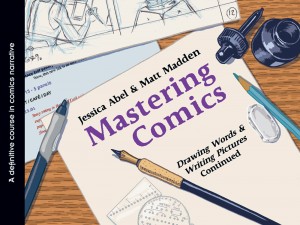Fleen Book Corner: Mastering Comics
Before we get into this, I think I have to thank Zach Weiner. But Gary, I hear you cry, Mastering Comics is by Jessica Abel and Matt Madden and Zach Weiner has nothing to do with it, so why thank him? Right you are, Sparky, and if you’ll simmer down for just a moment I’ll explain.
See, Mastering Comics: Drawing Words and Writing Pictures Continued (hereafter MC, and thanks as always to Gina Gagliano at :01 Books for the review copy) is, perhaps more than any book I’ve reviewed previously, not for me; it (and its predecessor) are textbooks, intended to be used in semester-long classes to teach people who are serious about comics the breadth and depth of skills necessary to that goal. I am the furthest from that person you can be and still love comics.
But Zach wasn’t a physicist or a mathematician when he decided to pull texts on those topics and start reading; he goes through, chapter by chapter, learning what he can, translating it to his own experiences, doing the exercises, and sharing what he learns. If he can do it, I can tackle the relatively easier task to telling you about a book.
Not that I wish to minimize the contradictions inherent in that task — if MC is skewed to the serious student (and keeping in mind, it’s not the introductory text), me being not being able to follow along isn’t an unreasonable thing; likewise, if I find it easy to absorb, that’s not necessarily a virtue. I decided to follow a rule of thumb from grad school¹ and figured if I could make sense of the first 40% or so of each topic and then get progressively lost, it was probably properly balanced.
On average, I followed the first 38% of each new topic.
Interestingly, I did better as I progressed through the text, as Abel and Madden made excellent use of repeated examples. Perspective, point of view, page layout — all were tracked from the earliest, sketchiest presentation, then refined further and further as more techniques were introduced. Inks, shades, and colors built upon a two panel excerpt of an outer-space story that followed a dozen or more different pathways and made me recognize subtle (and sometimes not-so-subtle) differences in end results that I’d never have noticed previously.
For me, the last-third portion of each discussion invariably came about when Photoshop tools and techniques were discussed. As I’ve mentioned more than once on this page, I am no kind of artist² much less a digital artist, but even here I was able to learn. The fundamentals of color reproduction are less mysterious to me and I have more of an idea what artist friends mean when they talk about “flatting” or “tones”.
Most interesting to me was the fact that about halfway through, Abel and Madden began talking about webcomics and essentially never stopped. Rather than define them as some kind of distinct beast, they became just another means for practice, and pretty much all of the remaining exercises involved incremental progress to a webcomic, culminating in posting that sucker for all to see. However, the ease of distribution and low barrier to entry of webcomics didn’t push out more traditional techniques; interleaved with the extended webcomics exercise were assignments to work up longform and shortform stories, make a mini, and even bookbinding.
Where I was able to fully engage once again was roughly in the final quarter of the book. Interspersed with the topics of production, Abel and Madden introduced material on professional concerns — schedules, collaboration, publishers and editors, agents, funding, distribution, marketing, publicity, even contracts and lawyers — all the things that might be shoved to the side in a purist exploration of capital-a Art. Those that want to make comics purely for themselves may find this section of less use, but for everybody that wants to be working in comics, I suspect it will be the most critical.
Mastering Comics belongs on the shelf of every serious student of the craft of comics; for the enthusiastic fan of the art, maybe not so much as books meant for more general (even “civilian”) audiences. For those wanting to learn by doing, and see how the skills required by webcomics relate to other forms of comics, it’s as indispensable as How To Make Webcomics or Making Comics (both of which are given their props in Mastering Comics). And if you happen to understand all the parts that baffled me, let me know how good they are. I suspect: very good.
_______________
¹ It was universally agreed that everybody should be able to follow along with the first third of your presentation, you should lose half the audience in the middle third, and by the end if you hadn’t left everybody scratching their heads and trying to work out the math, you hadn’t really figured out anything new.
² Although back in the day, with a t-square, drafting triagles, a compass, and engineering paper, I could construct circuit diagrams that were far more aesthetically pleasing than they strictly needed to be. I blame A Canticle for Leibowitz.

The above comments are owned by whoever posted them. The staff of Fleen are not responsible for them in any way.